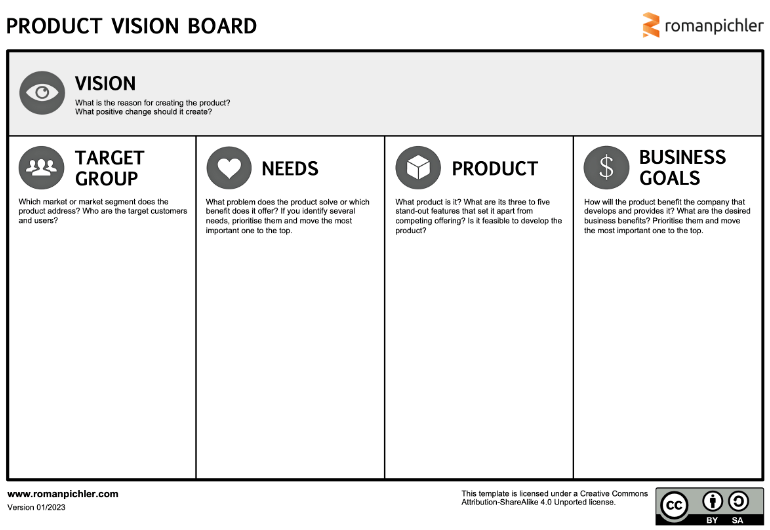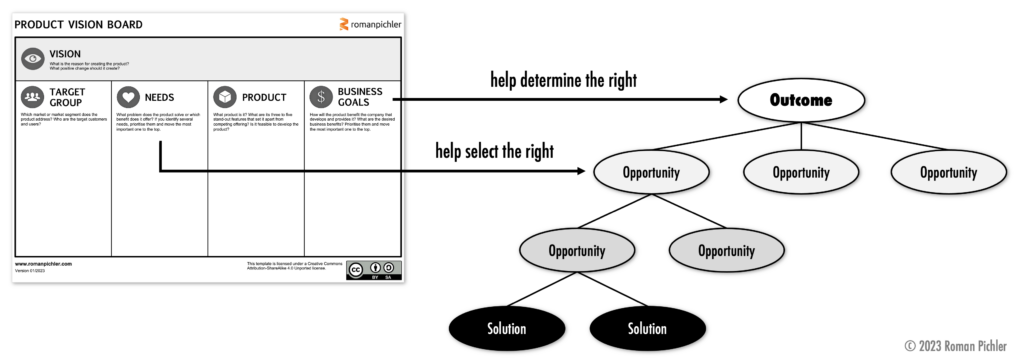Product discovery has become increasingly popular in recent years as a way to determine the right solution. In this article, I explain why you need a product strategy to succeed with product discovery, how the strategy helps you determine the right outcomes and opportunities, and how you can use the Product Vision Board to build an Opportunity Solution Tree.
Listen to the audio version of this article:
What is Product Discovery?
Product discovery is the process of “figuring out a solution to a problem we’ve been asked to solve,” writes Marty Cagan.[1] It involves understanding and selecting user needs, exploring solutions, and choosing the most appropriate one. Let’s make this more concrete by looking at a popular product discovery tool, Teresa Torres’ Opportunity Solution Tree (OTS).[2]
Before I proceed, let me point out that I am neither a product discovery expert in the sense discussed below nor do I fully endorse the specific approaches created by Marty and Teresa. My intention with this article is to show how product teams can use a product strategy to guide their discovery work and maximise the chances of creating successful products.
Let’s now get back to Opportunity Solution Trees. Such a tree contains three elements: An outcome, opportunities, and solutions. The outcome describes the business need that has to be addressed. It corresponds to the problem mentioned in Marty’s quote above. The opportunities represent the customer needs that, if addressed, will achieve the desired outcome. The solutions, finally, are the products or product capabilities that help solve the customer needs. Figure 1 shows how these elements form an Opportunity Solution Tree.
Without wanting to dive into the details of Opportunity Solution Trees —I recommend reading Teresa Torre’s book Continuous Discovery Habits to learn more about them—I’ll point out three main benefits they can offer.
- Encourage teams to start with outcomes—business and user/customer benefits—rather than outputs—features and deliverables. This avoids the risk of implementing features that add little or no value.
- Connect a business goal, customer needs, and solutions: You start with an outcome, determine opportunities, break them into smaller, more specific ones, and identify solution candidates.[3]
- Remind teams to consider different options and not prematurely commit to a single one.[4]
Like every tool, Opportunity Solution Trees also have drawbacks. A key issue I see is having the right business goal to start with. How is it determined? How can you be sure that it’s the right outcome to pursue, that others are not more urgent or valuable? To put it differently, if the business goal is wrong, you are likely to determine the wrong opportunities and discover the wrong features and user experience. It’s garbage in, garbage out.
To make things worse, this issue is not limited to Opportunity Solution Trees. It applies to product discovery in general. Luckily, there is a solution: Using a validated product strategy that provides the input of the product discovery work. [5]
What is a Validated Product Strategy?
I like to think of a product strategy as a high-level plan that helps you realise your vision and achieve product success. Such a strategy should answer the following four questions:
- Who is the product for? Who are the users and, if appropriate, who are the customers?
- Why would people want to use or pay for it? What specific problem does it address, or which tangible benefit does it offer?
- What are the business goals? Which benefits does the product create for the company developing and providing it?
- What kind of product is it and what makes it stand out? How does it differ from competing offerings? Why would people choose it over alternatives?
A handy tool to capture the product strategy is my Product Vision Board shown in Figure 2. It describes the strategy by using the sections “Target Group,” “Needs,” “Product,” and “Business Goals.” These sections correspond to the four questions above.
You can learn more about the Product Vision Board by reading the article The Product Vision Board and watching the video Introduction to the Product Vision Board. You can download the tool together with a handy checklist from my website.
While it’s great to capture the strategy of a product, it’s usually not enough. To maximise the chances that following it will result in a successful product, it must be based on empirical evidence and free of major risks. In other words, it must be validated. A great way to achieve this is to start with an initial strategy and iteratively test, correct, and improve it, as Figure 3 illustrates.
The process above consists of the following four steps:[6]
- Identify the biggest risk currently contained in the product strategy. Sample risks might be that the target group is too small, that the need identified is not compelling enough, that the product’s standout features are not strong enough, and that the business goals are not achievable.
- Determine the right method to address the risk such as direct observation, user interview, competitive analysis, and business modelling.
- Apply the method and collect the relevant data. For example, to test if the need is compelling enough you might carry out the user interviews and capture the answers in the form of notes or video footage.
- Evaluate the data and adapt the strategy. Follow this process until you have addressed the major risks in the strategy, and you have sufficient data to show that it is likely to result in a successful product—a product that is desirable, feasible, viable, and ethical, as I explain in more detail in my book Strategize.
How Does the Product Strategy Help with Product Discovery?
A validated product strategy provides you with the foundation for effective product discovery. It offers a context to choose the right outcome and determine the opportunities. More specifically, such a strategy offers you one or more business goals. As these have been tested alongside the rest of the strategy, you can be confident that they are the right business outcomes—that they have a meaningful business impact, are achievable, and have been correctly prioritised. This is great news, as this helps you determine the right input for the product discovery work.
There are three ways you can achieve this:
- You can choose one of the business goals on the product strategy and use it as the business outcome that enables the discovery of opportunities—the root node of the Opportunity Solution Tree.
- If the business goal selected is too big, you can derive a sub-goal from it. For example, if the goal is to “generate £200k of revenue in the next 12 months,” you might choose “make £50k in the next three months” as the outcome on the tree.
- Suppose you find yourself faced with a problem like declining engagement, poor retention, or low customer satisfaction. In that case, the product strategy enables you to check that fixing the issue will indeed help you meet the overarching business goals.
Additionally, a validated product strategy can help you determine the right opportunities, and it can accelerate product discovery. Here is why: Validating the strategy usually requires carrying out market and user research including observing and interviewing target users. This will help you identify the right opportunities, and it saves you from carrying out the work as part of the product discovery effort—you’ve essentially front-loaded your innovation process. What’s more, you can use the needs in the product strategy to guide the selection of the opportunities: Every opportunity should be a step towards meeting the overarching user and customer needs.
Figure 4 illustrates how the product strategy can guide product discovery and how the Product Vision Board can help build an effective Opportunity Solution Tree.[7]
No matter if you agree with my advice or if you follow the product discovery approach championed by Marty Cagan and Theresa Torres, make sure that you have correctly determined the target users and, if appropriate, customers, the problem the product should address or the benefit it should offer, the business benefits it should generate, and, especially for commercial products, the capabilities that make it stand out from competing offerings. This will enable you to take the next steps and determine the right solution—the right product features, user experience, technologies, and software architecture.
Notes
[1] See Marty Cagan, “The Origins of Product Discovery.” Marty has championed product discovery and shaped how most product people think about and approach the challenge of getting from outcomes to features.
[2] This characterisation is based on Teresa Torres’ book Continuous Discovery Habits: Discover Products that Create Customer Value and Business Value.
[3] This approach is not dissimilar to Impact Mapping, which suggests that you start with a business objective (why), determine the target customers (who), discover the benefit that the customers should experience (how), and finally, select the right solution (what). See Gojko Adzic’s book Impact Mapping. I am not the first person to note the similarity, see, for instance, Tim Herbig’s article “Using Impact Mapping to navigate Discovery” and Büşra Coşkuner‘s work on combining an Impact Map and Opportunity Solution Tree.
[4] This approach was first suggested by Set-based Design, as far as I know. See, for example, Jeffrey Liker’s book The Toyota Way: 14 Management Principles from the World’s Greatest Manufacturer, which discusses how Set-based Design is used in lean management.
[5] Note that I am not the first individual to recognise that product discovery should be guided by a product strategy, see Nacho Bassino’s book Product Direction, for example. I don’t, however, subscribe to the notion that discovery should be a stage or phase. Instead, I view it as an ongoing process—much like the effort required to evolve a product strategy. (I write about continuous strategizing in my book Strategize as well as in my strategy-related blog articles.)
[6] The validation approach is loosely based on Eric Ries’ book The Lean Startup and discussed in detail in my book Strategize.
[7] Note that the relationship between product strategy and product discovery is bidirectional. If the product team struggles to achieve the outcome and opportunities, this might indicate that the strategy is no longer valid and that it has to be adapted. To put it differently, the progress of the product discovery work can help determine if the product strategy has to be updated.





Post a Comment or Ask a Question